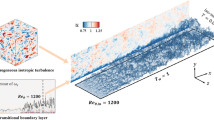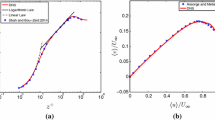Summary
Response of the atmosphere to a line-type heat sink, which represents a cold pool induced by evaporative cooling in falling precipitation, is investigated. Two-dimensional, steady-state, linear perturbations forced by the diabatic cooling in the presence of a critical level are solved analytically. The ambient flow is assumed to have a three-layer structure which is the same as that in Lindzen and Tung (1976, denoted as LT hereafter) except that an isolated diabatic cooling is specified in the lower layer. The shear layer with a critical level is assumed to be either dynamically stable or unstable. A steady-state solution is possible even for a dynamically unstable flow in the middle layer because the wave energy is allowed to propagate to infinity in the upper layer.
Thermally induced wave response near the critical level depending on the stability and wind shear in terms of the Richardson number exhibits the same behavior as the eigenvalue problem solved by Jones (1967) and LT because the source mechanism does not change the critical level behavior. That is, when the shear layer is dynamically stable, almost all of the wave energy is absorbed near the critical level, while for dynamically unstable case waves can be partially-or over-reflected from the critical level depending on the Richardson number. Waves can be over-reflected and over-transmitted simultaneously as they travel through the critical level in the process of the energy extraction from the unstable mean shear flow.
Using the duct condition proposed by LT, it is found that the magnitude of the perturbation vertical velocity in the lower layer is 6 times larger than that for a nonducting case with the same cooling rate. This implies that under a proper choice of the critical level height and stability profile, the response of the atmosphere to a line-type heat sink can be significantly enhanced through the over-reflection process.
Similar content being viewed by others
References
Bluestein, H. B., Jain, M. H., 1985: Formation of mesoscale lines of precipitation: Severe squall lines in Oklahoma during spring.J. Atmos. Sci.,42, 1711–1732.
Booker, J. R., Bretherton, F. P., 1967: The critical layer for internal gravity waves in a shear flow.J. Fluid Mech.,27, 513–539.
Bretherton, C., 1988: Group velocity and linear response of stratified fluids to internal heat or mass sources.J. Atmos. Sci.,45, 81–93.
Eliassen, A., Palm, E., 1960: On the transfer of energy in stationary mountain waves.Geofys. Publ.,22, 1–23.
Jones, W. L., 1968: Reflexion and stability of waves in stably stratified fluids with shear flow.J. Fluid Mech.,34, 609–624.
Klemp, J. B., Durran, D. R., 1983: An upper boundary condition permitting internal gravity wave radiation in numerical mesoscale model.Mon. Wea. Rev.,111, 430–444.
Lin, Y.-L., 1987: Two-dimensional response of stably stratified shear flow to diabatic heating.J. Atmos. Sci.,44, 1375–1393.
Lin, Y.-L., Chun, H.-Y., 1991: Effects of diabatic cooling in a shear flow with a critical level.J. Atmos. Sci. 48, 2476–2491.
Lin, Y.-L., Smith, R. B., 1986: Transient dynamics of airflow near a local heat source.J. Atmos. Sci.,43, 40–47.
Lindzen, R. S., Tung, K.-K., 1976: Banded convective activity and ducted gravity waves.Mon. Wea. Rev. 104, 1602–1617.
Lindzen, R. S., Barker, J. W., 1985: Instability and wave over-reflection in stably stratified shear flow.J. Fluid Mech.,151, 189–217.
Miles, J. W., 1961: On the stability of heterogeneous shear flows.J. Fluid Mech.,10, 496–508.
Ogura, Y., Liou, M.-T., 1980: The structure of a midlatitude squall line: A case study.J. Atoms. Sci.,37, 553–567.
Queney, P., 1948: The problem of air flow over mountains: A summary of theoretical studies.Bull. Amer. Meteor. Soc.,29, 16–26.
Raymond, D. J., 1984: A wave-CISK model of squall lines.J. Atmos. Sci.,41, 1946–1958.
Rosenthal, A. J., Lindzen, R. S., 1983: Instabilities in a stratified fluid having one critical level. Part I: Results.J. Atmos. Sci.,40, 509–520.
Rotunno, R., Klemp, J. B., Weisman, M. L., 1988: A theory for strong, long-lived squall lines.J. Atmos. Sci.,45, 463–485.
Skyllingstad, E. D., 1991: Critical layer effects on atmospheric solitary and cnoidal waves.J. Atmos. Sci.,48, 1613–1624.
Smith, R. B., 1979: The influence of mountains on the atmosphere. In: Saltzman, B. (ed.),Advances in Geophysics,21. New York: Acad. Press, 87–230.
Smith, R. B., Lin, Y.-L., 1982: The addition of heat to a stratified airstream with application to the dynamics of orographic rain.Quart. J. Roy. Meteor. Soc.,108, 353–378.
Thorpe, A. J., Miller, M. J., Moncrieff, M. W., 1982: Two-dimensional convection in non-constant shear: A model of midlatitude squall lines.Quart. J. Roy. Meteor. Soc.,108, 739–762.
Weisman, M. L., Klemp, J. B., 1982: The dependence of numerically simulated convective storms on wind shear and buoyancy.Mon. Wea. Rev.,110, 504–529.
Weisman, M. L., Klemp, J. B., Rotunno, R., 1988: Structure and evolution of numerically simulated squall lines.J. Atmos. Sci.,45, 1990–2013.
Wyss, J., Emanuel, K. A., 1988: The pre-storm environment of midlatitude prefrontal squall lines.Mon. Wea. Rev.,116, 790–794.
Author information
Authors and Affiliations
Additional information
With 7 Figures
Rights and permissions
About this article
Cite this article
Chun, H.Y., Lin, Y.L. Enhanced response of an atmospheric flow to a line-type heat sink in the presence of a critical level. Meteorl. Atmos. Phys. 55, 33–45 (1995). https://doi.org/10.1007/BF01029600
Received:
Revised:
Issue Date:
DOI: https://doi.org/10.1007/BF01029600




